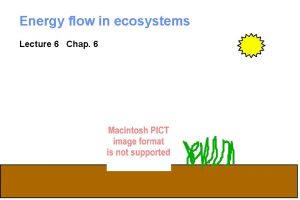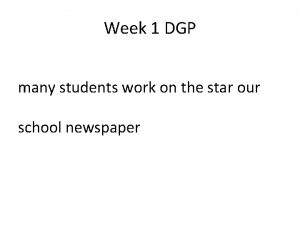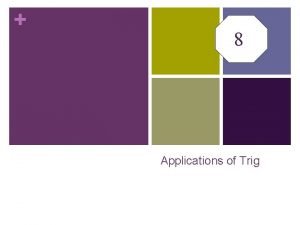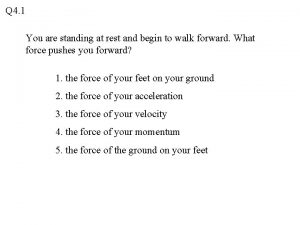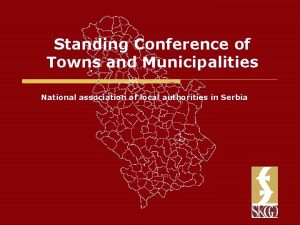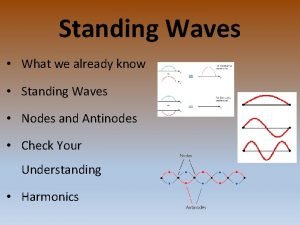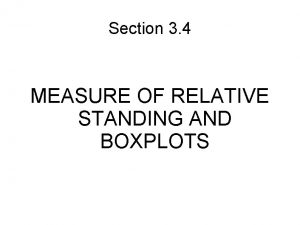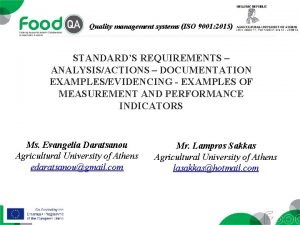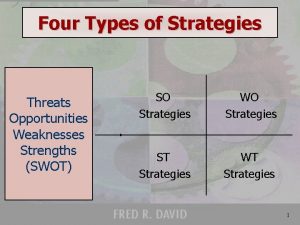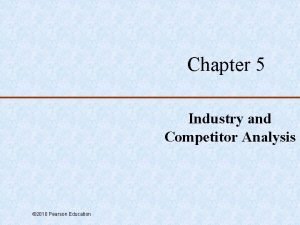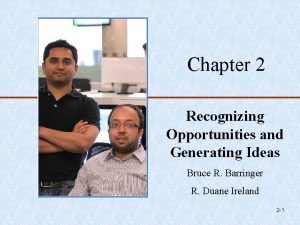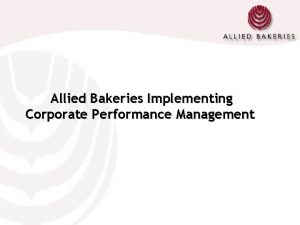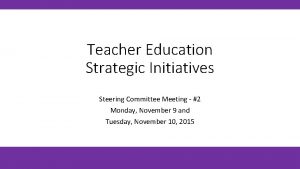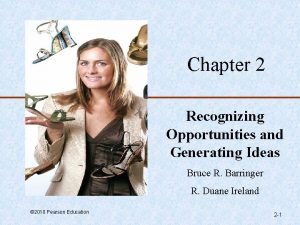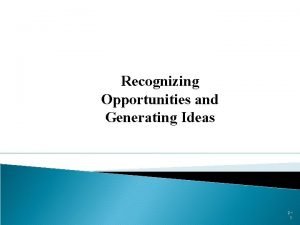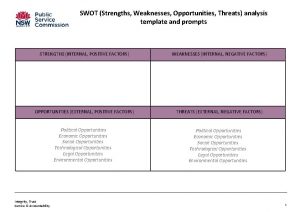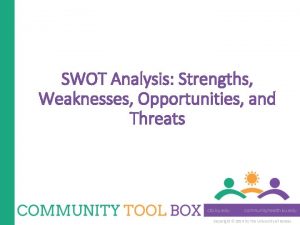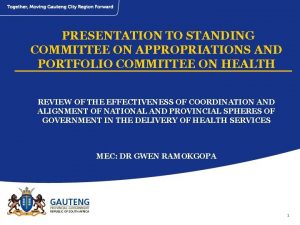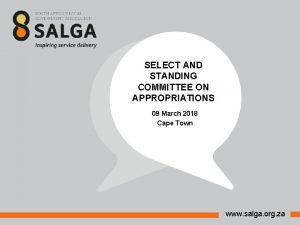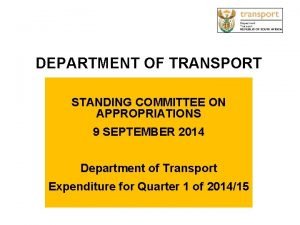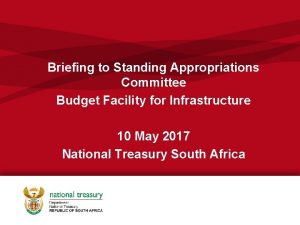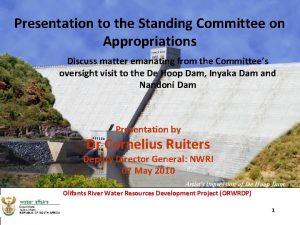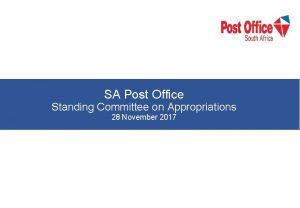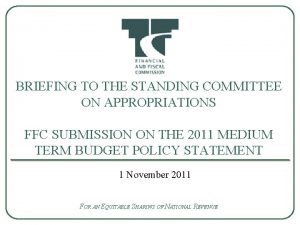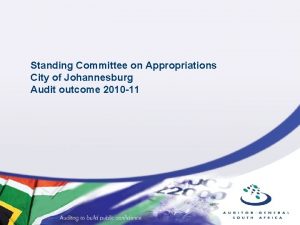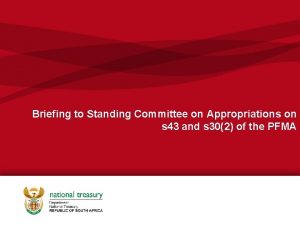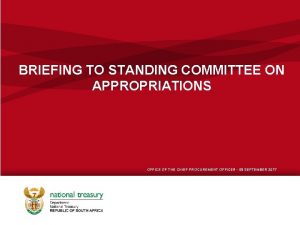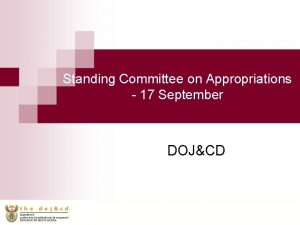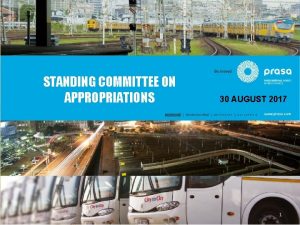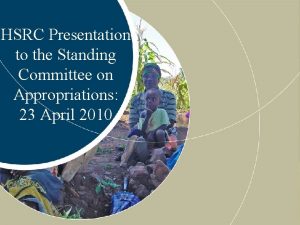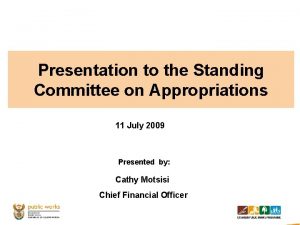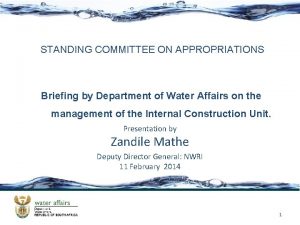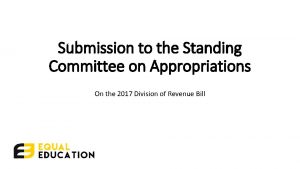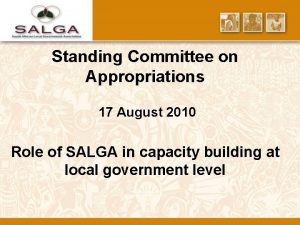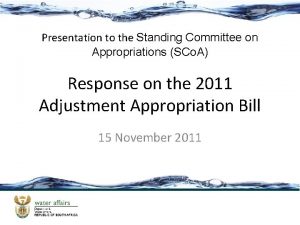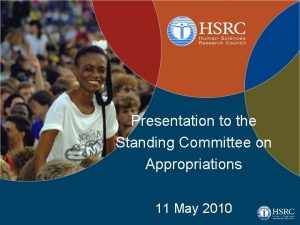STANDING COMMITTEE ON APPROPRIATIONS Challenges and Opportunities in




























- Slides: 28

STANDING COMMITTEE ON APPROPRIATIONS Challenges and Opportunities in Overall Water Management and Water Services Delivery Presentation by Nthabiseng Fundakubi Acting Chief Operating Officer 11 February 2014 1

Presentation Outline • Introduction • Challenges and opportunities in overall water infrastructure and water services delivery • Measures to streamline institutional arrangements( coordination and alignment of all water sector partners) for effective delivery of water services thus value for money • Measures to ensuring funding allocation earmarked for water projects is spent

Introduction • Local Government has the constitutional responsibility to ensure service delivery and Water Services Authorities (WSAs) in particular are required to plan, ensure access to and regulate the provision of water services (water supply and sanitation) within their area of jurisdiction. DWA on the other hand, has a responsibility to provide support and Regulate the use of water. • Local Government is also a water resource user and their activities have a major impact on water resources and its management.

Introduction continued • The Minister of Water Affairs is mandated through the National Water Act, 1998 to be the custodian of water resources so as to ensure that water is managed in an equitable, effective and sustainable manner. There is therefore a need to manage the whole water value chain.

Challenges in overall water infrastructure and water services delivery • Lack of integrated Planning leading to lack of alignment within the water supply service delivery chain. • Lack of funds to replace all the ageing infrastructure • Unsustainable, unaffordable operating and maintenance (O & M ) costs • Resistance to the use of Water Boards by some weak WSA

Challenges in overall water infrastructure and water services delivery (Continued) • • • Significant high unit cost for rural water supply particularly in KZN Demographics: Scattered and informal settlements over vast distances and over difficult terrain Complex sector and governance framework Skills and capability Historic water management model and approach

1759 Municipal Water Schemes Major coverage but O&M challenges • institutional & management implications ( 152 WSAs) • platform to inform: • new development • functionality / O&M • asset management • institutional arrangements 7

Extensive Water Services Infrastructure Bulk pipelines > 35, 000 km Reticulation >200, 000 km • Extensive spatial coverage (urban + rural) • major O&M implication (institutional, HR + Governance) 8

Water Management Challenges • Water is a complex resource: – Complex climate dependant, complex runoff system and complex harnessing processes – need expert management. – Highly variable (temporal) in space, and time! 70% of time runoff is below average, and then we have floods • Centrality of and respect for water: – Lack of respect and appreciation is reflected in terms of the way water is wasted, abused, polluted, prioritized and funded – Limited prioritization in sector planning and management e. g. IDPs – Lack of sector response and commitment

Water Management Challenges (continued) • Ensuring water security for growth and development – Fresh water balance at its limit in most Water Management Areas – Limited dam development opportunities – Challenge lies in funding, appropriate technology, affordability/viability, effective programme management and discipline, as well as timely implementation and sustainable management – Leads to major risks if not implemented in time

Water Management Challenges (continued) • Water wastage – Water losses of 38% (municipal average) in terms of water resource, infrastructure development and revenue loss perspective • Resource protection and water quality management – Habitat destruction and pollution (municipalities and industry) with major health, social, environmental and economic risks

Water Management Challenges (continued) • Water funding and lack of financial management – Inadequate financial management and discipline (tariff setting, cost recovery) – Lack of accountability in terms of use of equitable share – Poor implementation performance by local government (under spending and delivery) – Water resources not ring fenced – Debt management – Services viability and affordability (rural areas)

Measures to streamline institutional arrangements and Actions – Improved planning (integrated & business) and regulation – Application of business management principles and approach; – Stretching water, infrastructure and money paradigm shift: water loss management, resource optimization (re-use, systems operational management); – Sector mobilization, integrated governance and sector accountability; – Improved institutional framework; and – Focus on skills, capacity and capability development – National Water Resource Strategy: implementation

Measures to streamline institutional arrangements and Actions (Continued) • Water Reconciliation Strategies for 12 key growth centres: – sector involvement – Strengthen demand conservation management • Development of water investment framework – Present available funding less than 50% • Development of financing model: from appropriate solutions, financial discipline, self financing and cost recovery, to cross subsidization, grants and to investment funding • Infrastructure asset management and lifecycle management: focus on operations and maintenance

NSDP: Key demand centres (Water Reconciliation Studies)

Measures to streamline institutional arrangements and Actions (Continued) • Collaboration with Private Sector (Social responsibility); v Engage in Water Sector Partnership on funding of projects and capacity building and Improved partnership with associated Departments, and Provincial Governments • Improved municipal water financial management through engagement with National Treasury on changing the funding model ; • Application of and focus on life cycle management; • Focus on source to tap to source (integration) approach;

Measures to streamline institutional arrangements and Actions (Continued) • The DWA has adopted a philosophy called “source to tap” in addressing these challenges, which encourages partnerships and integrated planning between all stakeholders and all spheres of government involved in water management or delivery. • This means that each water service delivery project will focus on the following value chain components or attempt to understand how each component contributes and result in water availability at the endpoint. Sour ce BDS WTW BDS Reticu lation netwo rk Indust ry / Mines Rese rvoirs Retic ulatio n netw ork TAP

• • • Measures to streamline institutional arrangements and Actions (Continued) Improved planning through integrated infrastructure master plans (Outcome 9 actions); Improved project and programme governance (outcome action and PMU establishment); Commit to sustainable universal access to Water Supply Services (extended programme); Improved regulation; Establishment of regional water utilities; and Addressing water security through dedicate programmes (30% of municipalities at present at risk).

Measures to streamline institutional arrangements and Actions (Continued) • Integrated planning and governance (inter–departmental, provincial and sector collaboration): – Outcome management structures(Ministerial & Technical Implementation Committees) • Political Intervention – - Troika between Ministers of Dept of Water Affairs, Department of Cooperative Governance and Traditional Affairs and Department of Human Settlement - MOUs signed between Ministers and the Premiers • Sector Agreements (DBSA, CSIR) • SIPS : 1 on 1 and SIP 18 • Responding to National Development Plan • National Water Resource Strategy roll-out

Measures to streamline institutional arrangements and Actions (Continued) • Establishment of Programme Management Unit; • Sector mobilization and accountability ; • Integrated catchment management; – Establish 9 Catchment management agencies – Catchment forums • Establishment of regional water utilities; • National Water Infrastructure Agency; and • Implementing value chain (source to tap to outcome to source to impact) approach and model.

Measures to ensuring funding allocation earmarked for water projects is spent • Water Boards to take over projects that are not performing • To speed up implementation in the coming financial year , options of developing a supply side plan on material and equipment are being considered • Withholding of MWIG transfers if the Department is not satisfied with the performance of projects being implemented • Leadership from the Premiers on monitoring progress of water projects during the Premier Coordinating Forums(PCF) assisting in expenditure and delivery on the ground • Review funding model

BUDGET ALLOCATION MWIG 2014 MTES ALLOCATIONS REGION SCHEDULE 5 B 2014/15 EASTERN CAPE SCHEDULE 6 B 2015/16 2016/17 2014/15 2015/16 2016/17 157 979 269 922 253 276 83 707 179 921 220 403 0 0 0 54 410 84 680 89 168 263 622 861 781 777 437 47 020 103 775 229 678 LIMPOPO 27 379 51 698 54 438 190 471 453 266 477 289 MPUMALANGA 21 000 108 726 114 488 103 151 378 005 398 039 NORTHERN CAPE 64 170 87 713 102 363 0 0 0 46 067 92 082 96 962 534 150 1 379 840 1 302 002 524 826 1 291 729 1 511 545 0 0 0 534 150 1 380 205 1 302 002 524 826 1 291 729 1 511 545 FREE STATE KWAZULU NATAL NORTH WEST TOTAL: MWIG INFRASTRUCTURE GOODS & SERVICE GRAND TOTAL: MWIG INFRASTRUCTURE

BUDGET ALLOCATION (CONTINUED) TOTAL ACIP ALLOCATIONS PER CATEGORY Accelerated Community Water Supply R 60 836 Water Conservation and Demand Management R 93 761 Wastewater refurbishment R 90 773 National Office Programme Management & Contingencies R 1 588 TOTAL R 246 959 TOTAL ALLOCATIONS PER REGION Western Cape R 17 819 Northern Cape R 31 470 Eastern Cape R 37 523 Free State R 33 680 Kwa-Zulu Natal R 28 500 Mpumalanga R 20 912 Limpopo R 34 872 North West R 32 594 Gauteng R 8 000 National Office R 1 588 TOTAL R 246 959

BUDGET ALLOCATION (CONTINUED) REGIONAL BULK INFRASTRUCTURE PROGRAMME: 2014 MTEF BUDGET ALLOCATION Region Budget Allocation 2013/14 DWA Project Cost Proposed Budget Allocation 2014/15 Proposed Budget Allocation 2015/16 Proposed Budget Allocation 2016/17 EASTERN CAPE 3 686 565 781 590 156 497 985 952 000 1 157 000 1 115 386 000 FREE STATE 2 776 300 000 217 900 000 308 646 000 381 654 000 392 000 614 456 125 211 200 000 337 900 000 355 000 440 000 KWAZULU NATAL 6 389 279 939 595 263 275 1 178 150 000 1 333 200 000 1 228 000 LIMPOPO 3 672 340 820 642 521 725 749 299 000 841 667 000 945 217 000 MPUMALANGA 2 426 019 853 129 352 752 226 300 000 234 000 285 447 000 NORTHERN CAPE 3 288 904 224 340 965 429 310 749 000 339 299 000 419 030 000 NORTH WEST 2 689 232 660 377 734 243 349 450 000 426 600 000 593 522 000 806 011 534 169 203 079 134 150 000 153 234 000 205 000 0 72 041 000 75 416 000 93 110 000 104 295 000 26 349 110 936 3 346 338 000 4 656 012 000 5 314 764 000 5 727 897 000 GAUTENG WESTERN CAPE HEAD OFFICE TOTAL

GOING FORWARD Measures to put in place to minimize under spending • • • Enhanced planned; Improved accountability on the implementation agents; Reprioritize projects for quicker completion; Strengthen control on reporting mechanism; Support municipalities especially in assisting with fast tracking implementation of projects as well as complying to the provision of DORA, MFMA and PFMA. 25

ENABLERS TO IMPROVE SERVICE DELIVERY • Early warning strategy §Established Emergency Response Team supported by appropriate technology • Communication with stakeholders (Internal and External) §Blitz §Whatsapp §Information System and Customer Care • Utilisation of retired engineers §Consultation with the database of Public Works • Expanded Public Works Programme §Utilization of the Environmental Monitors • Building of capacity within DWA to effectively support municipalities 26

Conclusion • Infrastructure is a critical part of water and water services management, and must receive the highest priority attention • However, water management also includes water governance, programme management and enabling actions (skills, coordination, information, research and knowledge). These must also be funded appropriately • Extended attention must be given to life cycle management, service quality and viability • Funding of environmental and social business requires special solutions (non economic development) • DWA has initiated various actions to address and improve services delivery

THANK YOU 28
 Difference between standing crop and standing state
Difference between standing crop and standing state What is the opportunities and challenges of informational
What is the opportunities and challenges of informational Greater bay area opportunities and challenges
Greater bay area opportunities and challenges Constructive interference of standing waves
Constructive interference of standing waves The family and its social standing
The family and its social standing Adrenoglands
Adrenoglands Standing
Standing Both greta and fred were on the bus that arrived
Both greta and fred were on the bus that arrived A triangular playground has sides of lengths 475
A triangular playground has sides of lengths 475 A horse is hitched to a wagon. which statement is correct
A horse is hitched to a wagon. which statement is correct Honorably hold a name and standing
Honorably hold a name and standing Standing conference of towns and municipalities
Standing conference of towns and municipalities Standing wave
Standing wave What is a measure of relative standing
What is a measure of relative standing Actions to address risks and opportunities
Actions to address risks and opportunities Wt strategies
Wt strategies Competitive analysis grid
Competitive analysis grid What is new entry in entrepreneurship
What is new entry in entrepreneurship Trends and opportunities examples
Trends and opportunities examples Factbranch
Factbranch Swot analysis of a teacher
Swot analysis of a teacher Swot analysis for english students
Swot analysis for english students An opportunity has four essential qualities it is
An opportunity has four essential qualities it is Career opportunities in biotechnology and drug development
Career opportunities in biotechnology and drug development Recognizing opportunities and generating ideas
Recognizing opportunities and generating ideas Strengths weaknesses opportunities and threats template
Strengths weaknesses opportunities and threats template List of opportunities and threats
List of opportunities and threats Spouse education and career opportunities
Spouse education and career opportunities List of opportunities of a student
List of opportunities of a student
